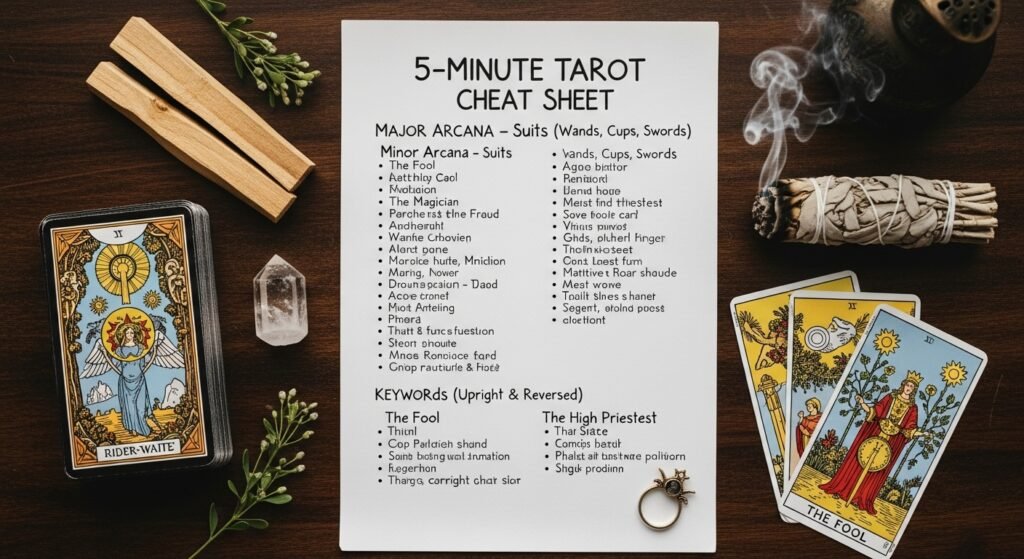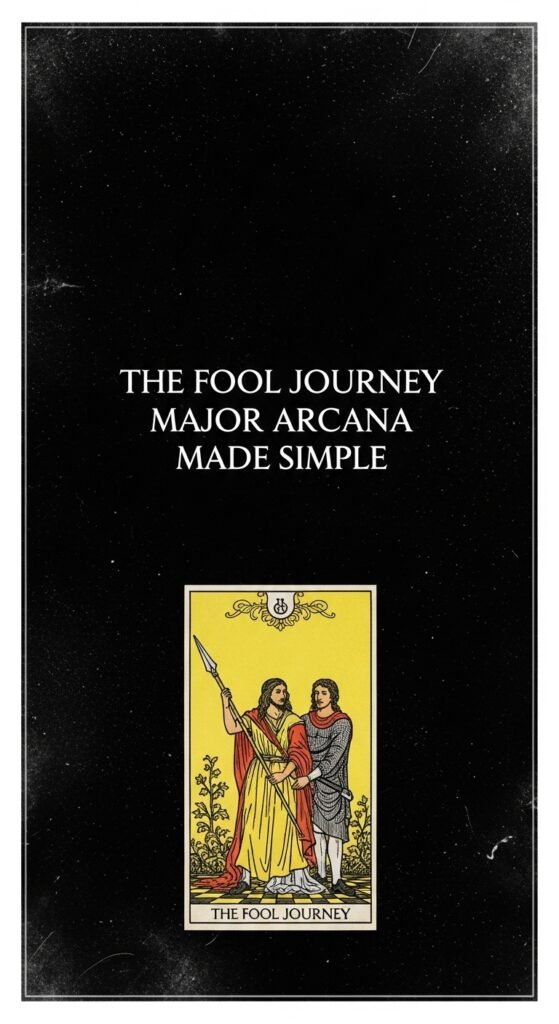
Tarot can feel overwhelming for beginners—78 cards, upright and reversed meanings, symbols, and spreads. But it doesn’t have to be complicated! With this quick 5-minute cheat sheet, you’ll learn how to read tarot with confidence, trust your intuition, and start giving powerful readings right away. Whether you’re curious about love, career, or spiritual growth, these simple tips will make tarot easy and fun to use.
1. The Fool’s Journey: Major Arcana Made Simple

The Major Arcana cards are the heart of tarot, representing life’s biggest lessons and spiritual milestones. Think of them as chapters in a story called “The Fool’s Journey,” which begins with The Fool—symbolizing new beginnings and curiosity—and ends with The World, representing fulfillment and completion. These 22 cards highlight transformative experiences, soul growth, and key turning points in your life. When a Major Arcana card shows up, it carries more weight than a Minor Arcana card, signaling that the situation or lesson is deeply significant. By learning their core meanings, you’ll unlock the essence of tarot readings quickly.
2. Minor Arcana Basics: Everyday Life Themes
The Minor Arcana cards make up the bulk of the tarot deck and represent the smaller, day-to-day experiences that shape your life. Unlike the Major Arcana, which focuses on big life lessons, the 56 Minor Arcana cards reflect your emotions, choices, and daily challenges. They’re divided into four suits: Cups (emotions and relationships), Pentacles (career and finances), Swords (thoughts and struggles), and Wands (creativity and action). Each suit tells a story, much like a mini-movie about that area of your life. By understanding these suits, you’ll see how tarot applies to both major events and everyday situations, making your readings feel practical and insightful.
3. Numerology Shortcuts for Quick Reads
Numbers in tarot hold deep symbolic meaning and can help you interpret cards quickly without memorizing every detail. For example, Aces (1) represent new beginnings and potential, while Twos signify balance or decisions. Threes indicate growth, Fours stability, Fives challenge or change, and Tens completion or new cycles. By learning the number patterns, you can instantly understand the overall theme of any card. Combining numerology with the card’s suit gives you a complete picture—like “Two of Cups” meaning a balanced or blossoming relationship. This shortcut makes reading tarot much faster and more intuitive.
4. Reversals Made Easy
Reversed tarot cards often intimidate beginners, but they’re not always negative. Instead of meaning “bad news,” a reversal usually suggests blocked energy, delays, or an internal struggle related to that card’s upright meaning. For example, The Sun reversed may not mean unhappiness, but rather temporary confusion or a need for clarity. Reversals invite you to look deeper, encouraging reflection on hidden factors or subconscious feelings. Some readers choose not to use reversals at all, focusing only on upright meanings. Whether you include them or not, understanding reversals adds depth and nuance to your readings.
5. Quick Keywords for Each Suit
Assigning simple keywords to each tarot suit makes reading cards faster and more intuitive. Cups represent emotions, love, and relationships, helping you understand emotional situations. Pentacles focus on money, career, and material matters, showing practical outcomes. Swords relate to thoughts, communication, and challenges, highlighting mental or intellectual struggles. Wands symbolize creativity, passion, and action, pointing to motivation and energy. By memorizing these keywords, you can interpret cards at a glance without needing lengthy definitions. This shortcut simplifies readings while keeping them accurate and meaningful.
6. Three-Card Spread Cheat
The three-card spread is one of the simplest and most versatile tarot spreads, perfect for beginners and quick readings. Each card has a clear role: Card 1 represents the past or the root cause of the situation, Card 2 shows the present circumstances, and Card 3 points to the future or guidance. This layout works for any question—love, career, or personal growth—and gives a concise snapshot of the situation. It helps you practice interpretation without feeling overwhelmed by complex spreads. Using this method regularly builds confidence and strengthens your intuition with each reading.
7. Trust Your Intuition First
While guidebooks and card meanings are helpful, your intuition is your most powerful tool in tarot. Pay attention to the images, colors, symbols, and emotions a card evokes—these often carry more insight than memorized definitions. Trusting your gut allows you to connect personally with the cards and interpret messages that are uniquely relevant to your situation. Over time, your intuitive readings will become more accurate and meaningful, creating a deeper connection with the tarot. Remember, the cards are a mirror for your inner wisdom.
8. Visual Storytelling is Key
Tarot cards are like a visual storybook, and learning to “read the pictures” is essential for insightful interpretations. Instead of memorizing every card meaning, focus on the imagery, colors, symbols, and characters. Ask yourself, “What story is this card telling me?” or “What emotions does it evoke?” This approach makes readings feel natural and intuitive. By connecting with the visual narrative, you can uncover messages and guidance that resonate deeply with your life, making tarot both practical and personal.
9. Ritualize Your Readings
Creating a simple ritual before your tarot readings helps you focus and protect your energy. This could include cleansing your deck, lighting a candle, setting an intention, or shuffling mindfully. Rituals signal to your mind and spirit that it’s time to connect deeply with the cards. Even small routines can make readings feel more powerful, accurate, and personal. Over time, ritualizing your practice builds consistency and strengthens your intuitive connection with the tarot.
10. Keep a Tarot Journal
A tarot journal is an essential tool for tracking your growth and improving your readings. Write down your daily pulls, interpretations, and any insights that arise during each session. Over time, you’ll notice patterns, recurring themes, and how your intuition evolves. Journaling also helps you reflect on past readings, making future ones more accurate. This simple practice deepens your connection to the cards and turns tarot into a personal guide for self-discovery and clarity.
Conclusion: Tarot Made Simple and Powerful
Tarot doesn’t have to be complicated or intimidating. With this 5-minute cheat sheet, you now have the tools to read cards confidently, trust your intuition, and uncover meaningful insights quickly. By understanding the Major and Minor Arcana, using simple keywords, practicing spreads, and connecting with the imagery, you can give accurate and personal readings. Remember, tarot is less about memorization and more about intuition, reflection, and storytelling. Start small, practice consistently, and watch your tarot skills—and your self-awareness—grow.